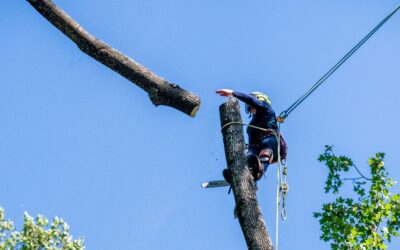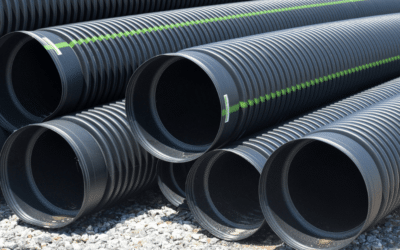Blog Topics
Lawn aeration is key to a green, healthy lawn. If you have a lawn (even a tiny one), keeping it aerated ensures you’ll have a healthy, green oasis to relax in all summer long. In this article, you’ll learn about why aerating your lawn is important, including:
- How aeration benefits your lawn
- When to aerate your lawn in northern Virginia
- The best way to aerate your lawn
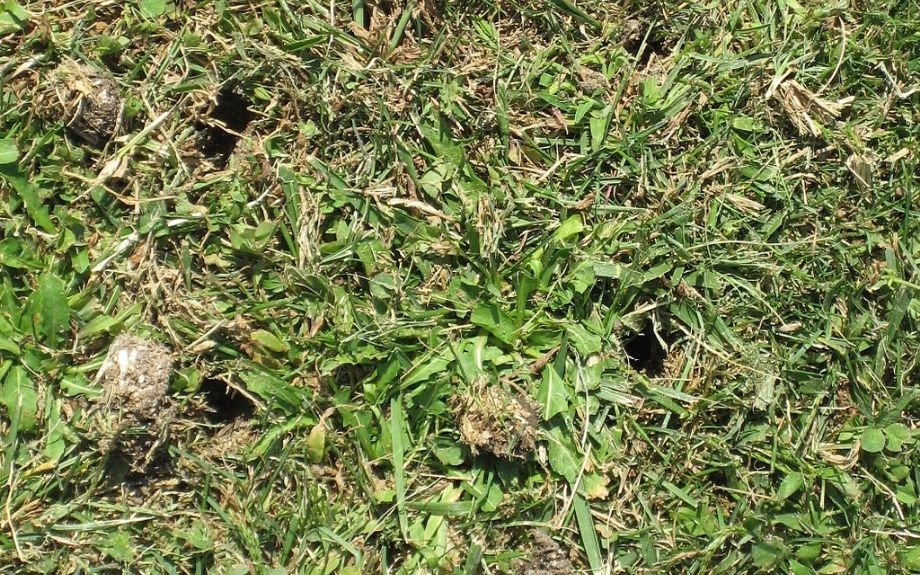
Lawn aeration holes. By Guipozjim – Own work, CC BY 3.0, https://commons.wikimedia.org/w/index.php?curid=9898765
What is lawn aeration?
Lawn aeration is the process of opening up compacted soil or breaking through lawn thatch to allow better moisture penetration, root growth, and air circulation for both warm season and cool season turfgrass lawns.
Is lawn aeration worthwhile?
In a word, yes. If you’re aerating your lawn, you’re helping create an ideal environment for vigorous grass growth. When turfgrass is growing in open, porous soil, you’ll also avoid some common, unwanted lawn conditions, such as moss growth and fertilizer runoff.
How does lawn aeration work?
Lawns can be aerated either manually or with specialized lawn aeration equipment.
Lawn aerators remove narrow, 2-3” long cylinders (or cores) of compacted soil from your grass at regular intervals. These cored areas create a grid of small“open windows” around the base of your lawn grasses, near their roots. These small openings let in air, water, and fertilizer so they quickly reach the grasses’ root system, right where they’re needed.
The cores are left on the lawn surface and dissolve over time (usually in about 2 to 4 weeks, more quickly when wetted by irrigation or rainfall), providing a quick top-dressing for your lawn.
Because these cores of soil are small and calibrated to your lawn’s growth habit, your lawn won’t suffer any damage by aeration. Most lawns are made up of turf grasses that develop dense, fibrous root systems, and their root systems benefit from being periodically opened up.
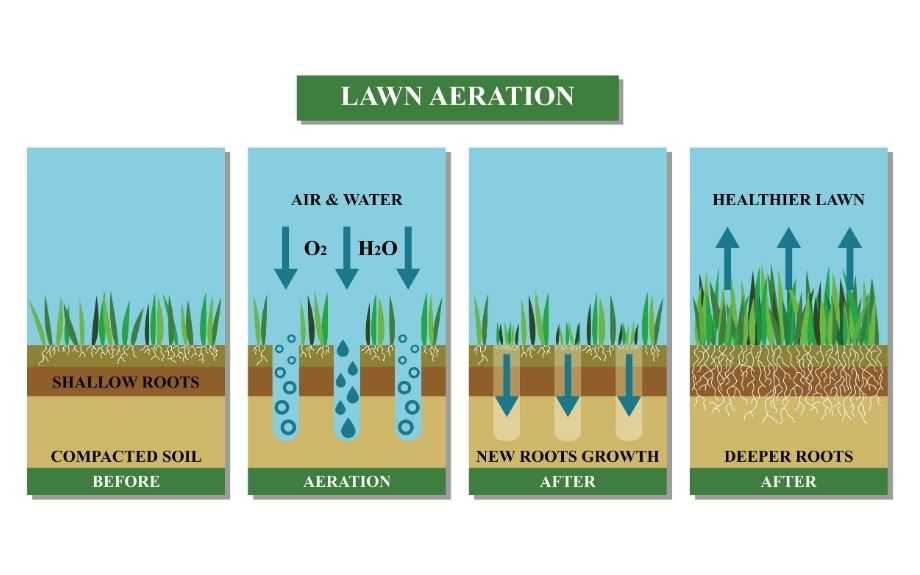
How does lawn aeration help keep turfgrass healthy?
If your lawn is struggling to grow and keep its brilliant green color, it may be because the soil it’s growing in is compacted. Compacted soil is very common in northern Virginia. It prevents water, air, and nutrients from reaching the roots of turf grasses, and results in a yellowing or patchy lawn, stunted growth, and areas of moss and weeds.
Another common problem is thatch buildup. This layer of dead and living grass stems builds up on the soil surface and can be difficult for water, air, and fertilizer to penetrate. While all lawns have some thatch, it doesn’t become a problem until it builds up to about half an inch or more. At that point, you’ll notice that your lawn has a spongy feel, it may be more affected by lawn pests and diseases, and will generally fail to thrive.
Aeration Helps Keep Lawns Properly Watered
Compacted soil can form a surface that repels water and will dry out your lawn because irrigation water rolls off. Conversely,it can absorb water and not drain, making it saturated.
Aerating your lawn will help with both of these problems. The aerator will create regularly spaced, open channels into your lawn’s soil. These open shafts will let excess water evaporate from saturated soil and let irrigation water soak into dry soil. Plus, because there’s less (or no) water runoff, you’ll save money on your irrigation bill.
Aeration Makes Fertilization More Effective
Your lawn may need fertilization throughout the year, starting in early spring. When you’ve aerated your lawn and created a network of open areas in your soil, the fertilizers you apply (in liquid or granulated form) will land in just the right place, at the roots of your turf grasses.
Aeration Enhances Grass Seed Germination
If your lawn is looking a little worn out or thin, you may want to overseed to fill in any sparse or winter-damaged patches while you’re fertilizing. Compacted soil can make it impossible for grass seeds to get a foothold in the soil and grow. The grid of tiny soil openings that a lawn aerator creates is ideal for seed germination, and the new grass seeds will fill in bare spots and make your lawn even and lush.
Aeration Reduces Problems due to Thatch
Because core aeration helps to remove and break down excessive thatch, it also helps to remove the dense barrier that hides and protects insect pests and promotes lawn diseases. As a result, you’ll have a healthier and more attractive lawn without needing to spend more money on pest or disease treatment.
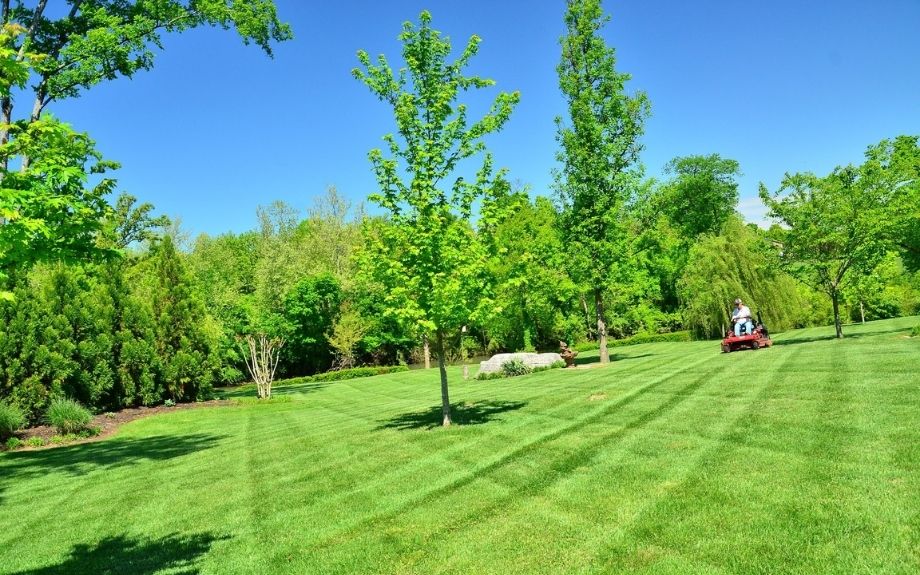
Why should you aerate your lawn?
You should aerate your lawn regularly, as needed, to keep it in top shape. A new, healthy lawn growing on well-draining soil may not need aeration yet. But if you have an existing lawn you should be aerating, especially if you’ve ever had drainage problems, lawn yellowing, or if your grass is growing slowly or irregularly.
You may not think about it, but lawns get a lot of activity that contributes to soil compaction. Even if you don’t use your lawn all the time, normal activities can compact soil over time.
- Running and sliding on a lawn can compact the soil beneath the grass, especially if it’s wet. Active play of any kind can add to soil’s compaction, and wet soil is more vulnerable to compacting than drier soil.
- Parking a vehicle, even temporarily, on a lawn will compact the soil beneath it. The small surface areas of a car’s tires carry all the weight of the vehicle and then transfer that weight onto the soil.
- Regular rainfall will compact soil, as the accumulated force of raindrops over time will pound on soil and create a water-rejecting crust.
- Even regular mowing can contribute to soil compaction from the weight of the mower repeatedly passing over the same areas!
When should you aerate your lawn?
Northern Virginia lawns aren’t all the same, and different types of lawn grasses need different care.
Fall Lawn Aeration for Cool Season Grasses
In Fairfax and Loudon counties, you may have a lawn made up of cool season grasses such as fescue, which grow rapidly in the cooler late summer.
September is a good time to aerate this type of lawn, as your grass is growing fast at this time of year and needs water and air circulation. Aerating when your grass is growing also lessens the chance of weeds sprouting up, as vigorous grass growth will shade out weed seeds trying to germinate.
Summer Lawn Aeration for Warm Season Grasses
If your lawn is composed of warm season grasses, such as bermuda grass or zoysia grass, you’ll want to aerate earlier. A good time to aerate warm season lawns is June or July when temperatures are high and the grasses are growing fast.
Just as with cool season lawns, aerating warm season grasses at the right time ensures enhanced growth and less chance of weeds.
Spring Lawn Aerationfor All Types of Lawns
In Northern Virginia, spring lawn aeration can improve growing conditions for all types of lawns, as it benefits the soil that supports both cool and warm season grasses.
But hot summer weather isn’t far off, so we don’t recommend overseeding your lawn in spring after you’ve aerated. If you overseed with cool season grass, those young shoots won’t have developed enough by summer to endure the hot temperatures.
PRO TIP: Not sure about what kind of lawn you have? Read more about grass types in Fairfax County.
How often should you aerate a lawn in northern Virginia?
Generally, you should aerate your lawn annually, although this depends on the age and condition of your lawn and your soil type. For example, a newly installed lawn or a lawn growing in naturally well-drained, organic soil may not compact as quickly as other soil types, and thatch may not be an issue. On the other hand, clay soils and playing fields tend to compact quickly and will benefit greatly from more frequent core aeration.
PRO TIP: Aerating your lawn too much can damage your grass, so don’t overdo it. If you’re aerating regularly but still have problems with the health of your grass, ask a turf professional for an evaluation. You might have a larger issue with drainage, which is something we can help remedy.
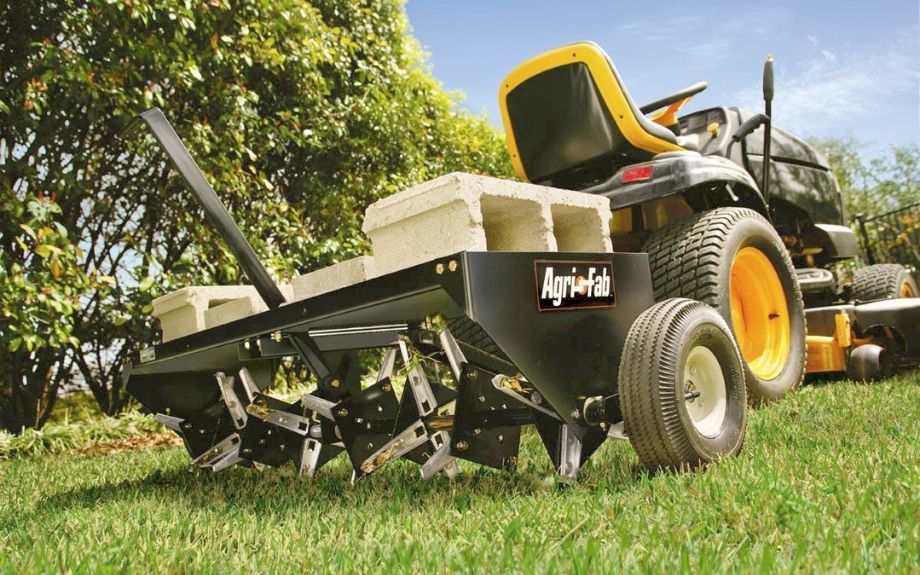
What tools are best for lawn aeration?
Lawn aeration tools vary widely. From spiked shoe covers that you walk into riding lawn-mower attachments, there’s a tool for every size and type of lawn.
Small Lawn Aerators
If you have a small lawn, you can aerate it with a hand aerator. This tool has a row of prongs or corers attached to a flat plate that welded to a long handle with a “T” top (like a water meter valve key). You step on the plate and, as with spiked shoes, use your own body weight to push the aerating prongs into the soil.
NOTE: These DIY methods are fine for small areas, but their application isn’t uniform enough (or fast enough) for large and sloping lawns.
Larger Lawn Aerators
Aerators for large lawns include:
- Riding aerators you drive standing up like a lawnmower
- Spiky aerator attachments that are attached behind a riding mower
- Wheel cover aerators that you attach like snow chains to your lawnmower
These types of aerators allow you to cover large areas of lawn quickly and aerate in a uniform pattern. Homeowners may even be able to rent a lawn aerator from local rental companies.
We’ve found the best method for lawn aeration is an Aeravator. This piece of equipment surpasses traditional aerators because instead of removing cores of soil from a lawn (where they stay and may be an eyesore), it simply creates small fissures or fractures in the soil with its rows of long tines.
We use an Aeravator because of its superior soil-loosening abilities, and because it solves the problem of aerator plugs or cores left behind on a lawn. Together, these two benefits mean we can ensure precise, even, and tidy lawn aeration for all types of lawns.
Need a Hand?
If you’ve got a lawn that’s too big for you to regularly mow, fertilize, and aerate, or if you’re just not sure about the best lawn care methods for your garden, give us a call. We’re professionals with experience in all aspects of garden and lawn care.
And, importantly, we design and install gardens and lawns so we’re up-to-date on the best practices for fertilizing and maintaining healthy, lush gardens.
Give us a call at 703-783-7571 and we’ll help get your lawn in tip-top shape for year-round enjoyment!
Give Us a Call at 703-402-9366
If you'd like help with your trees or landscape, have any questions, or would like to schedule an appointment with one of our Certified Arborists, please give us a call. We'd love to hear from you!

